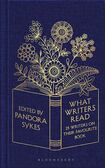
“A child’s reading is very different to an adult’s. An adult begins each book critically: suspiciously, even. Is this writing any good, has the writer got anything to say? A child takes on trust whatever book is in her hands – filling out its thinness, if it is thin, with her own imagination.” This is the English author Tessa Hadley, in typical wise form, on the joy of reading as a child, that sense of spirit-shocking wonder at new worlds, characters, ideas, unburdened by judgment or comparisons, just the simple pleasure of a good book in the right hands.
What Writers Read, a new anthology edited by Pandora Sykes, is full of such nuggets, comprising 35 short essays from contemporary writers on a book that shaped them. The list of contributors is impressive, ranging from literary to commercial fiction, established to emerging authors from the UK and further afield, among them, last year’s Booker winner Damon Galgut, Diana Evans, Ali Smith, Nick Hornby, Derek Owusu, Meena Kandasamy, Sebastian Faulks and Dolly Alderton.
[ Online forums’ crime obsession inspired my novelOpens in new window ]
Irish authors include Emma Dabiri, Naoise Dolan, Kit de Waal and Marian Keyes, whose short biographical note is a reminder of her phenomenal success: 40 million books sold worldwide. Keyes’ ode to Cold Comfort Farm by Stella Gibbons, read during a difficult solo holiday to Santorini in her late 20s, is one of many contributions that detail how writers are shaped by other writers, particularly when starting out: “I thought of this book, and how you have to intrigue people, how you have to pull the rug from under their feet, and how you have to be funny.” Kit de Waal, meanwhile, opens her essay with the memorable line: “When I first read The Thing About December by Donal Ryan, I felt sick with jealousy.”
All of the essays engage – there isn’t a dud in the bunch –, which is perhaps a result of their succinct length, on average four to five pages, but also down to the honesty and thoughtfulness of the contributors. As a journalist, writer and avid reader, Sykes is a good choice for editor. Her introduction has some stark statistics. More than 413,000 children in the UK don’t own a book. More than 800 public libraries have closed in the last 10 years, which Sykes points out is “rarely front-page news, but an emergency nonetheless”. All proceeds from What Writers Read will go to the National Literacy Trust, an independent London-based charity, and their efforts to create 1,000 new libraries in British primary schools in the coming years.
Piers Morgan: ‘My DNA is predominantly Irish whether Ireland wants that or not’
Allen Bobinac: ‘For four weeks, I was sleeping in Stephen’s Green, surviving on €1 a day’
‘Dún Laoghaire is a place of such contrasts - it has yacht clubs and sunshine, but also a darker side’
Golfer Leona Maguire: ‘We came from a modest background. I don’t need a lot of money to keep me happy’
[ Poem of the Week: DaffodilsOpens in new window ]
Like the best kind of selection box, anthologies of this ilk offer a window into the lives and predilections of writers (see also: This Women’s Work, edited by Sinéad Gleeson and Kim Gordon). There’s the satisfaction of a writer you love picking a book you love, like Ann Patchett on Meg Mason’s Sorrow and Bliss, “a book of profound emotional depth that makes the reader bark like a seal”, the discovery of books you’ve never heard of – Damon Galgut’s tribute to Denis Johnson’s novella Train Dreams – or the ones that went on the pile so long ago, you’ve forgotten about them: Moon Tiger by Penelope Lively, chosen by Taiye Selasi.
One of the more interesting motifs that emerges across the collection is the importance of timing when it comes to reading. Here’s Paris Less on The Beach by Alex Garland: “A book to read when you’re discovering life, and hormones make the world exciting and intense”. The age of 12 crops up frequently: Ruth Ozeki on The Pillow Book by Sei Shōnagon; Elizabeth Day on Agatha Christie; Naoise Dolan’s pleasingly eccentric choice of Schott’s Original Miscellany by Ben Schott. Emma Dabiri perfectly encapsulates the timing issue in her astute piece on rereading Nella Larsen’s Quicksand: “That a book I could feel so ambivalent about could touch me so personally a decade later.”
The connections between writers make for more interesting titbits. Leila Slimani writes about corresponding with her literary idol Milan Kundera. Caleb Azumah Nelson’s excitement at meeting Zadie Smith at an awards show is palpable. Ann Patchett talks about her friendship with Meg Mason. Elsewhere, the remit of the book elicits essays on the past: formative, seminal moments involving books.
While personal in tone, a number of the essays are political. William Boyd read Catch 22 during the civil war in Nigeria. Elif Shafak notes of Virginia Woolf’s Orlando that “if this book had been written by a Turkish writer, it would most probably be attacked, censured or even prosecuted in my motherland”. Orlando’s gender-fluid protagonist comforts a younger Shafak about her own sexuality. Above all, the power of books to instruct and enlighten is what comes through from the essays in this engaging anthology. Or as Deborah Levy puts it: “I suppose the point of reading at any age is that one life is not enough”.












